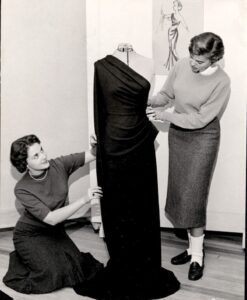History
Department of Consumer, Apparel and Retail Studies
History
Believe it or not, clothing and textiles have been a part of UNCG’s history since its beginning in 1892. Its first president, Charles McIver, thought that women needed to be educated not only for teaching or secretarial work, but also for their inevitable task of homemaking. Therefore, all students were required to complete courses in foods and clothing along with liberal arts. By 1904, students could major in Domestic Arts, which was clothing and textiles. In these early years, the clothing and textiles curricula included sewing, design, textiles, color, textile manufacturing, historic textiles, and millinery.
In 1917, the Department/School of Home Economics was established, and the college was renamed The North Carolina College for Women. From 1917 to 1936, the Department was called Clothing and Textiles and Housing. In the 1920s considerable building took place on the campus. The Home Management House on McIver Street was completed in 1922 and the Home Economics Building in 1928. The first Bachelor of Science Degree in Home Economics was conferred in 1922, the first Master of Science Degree in 1928.
By 1931, the North Carolina Legislature consolidated the three state-supported institutions (North Carolina State University, UNC Chapel Hill, and NC College for Women) into one system: The University of North Carolina.
In the consolidation plans, Home Economics was to be moved to the Chapel Hill campus, but Greensboro refused. Home Economics remained at Greensboro and the University became popularly known as “WC” or formally as The Woman’s College of The University of North Carolina.
The curriculum in the Department/School expanded to reflect changing needs of individuals and families. Federal legislation provided funds to assist with the education of teachers and extension agents. In the 1930s, the clothing curriculum included courses in clothing selection and construction, pattern study, textile analysis, economics of textiles, and history of both textiles and costume. In 1937, two faculty donated artifacts of textiles and laces, which established the Costume Collection.

The School of Home Economics was formed by reorganization of the College of Arts and Sciences in 1949. In 1952, a new building was completed and the 1928 building became a wing. It was not until 1957 that the new building was named the Mary Frances Stone Building. By the 1960s, more graduate education led to the establishment of the PhD in Clothing and Textiles, one of the first PhD degrees on campus.
The focus of Clothing and Textiles changed to include greater emphasis on textiles. The 1950-60s was the era of expansion for synthetic fibers with focus on fiber performance, finishes and modification, appropriate end use, and consumers’ selection and care of garments. The local textile industry was supportive in assisting with textile-testing equipment and funding. Burlington Industries funded an Excellence Professorship in Textiles in 1960, and in 1970 Fieldcrest, Inc. funded a student internship for a student with junior class standing.
In 1975, Clothing and Textiles emphasized fashion merchandising in addition to textile science and apparel arts. The first supervised internships and industry advisory board were established in 1984. International contacts grew through faculty travel and foreign students pursuing graduate study. In 1989, an endowed Distinguished Professorship was created in honor of Charles A. Hayes, CEO of Guilford Mills.
In 1990, the Department underwent a major curriculum revision.Two concentrations were established at the undergraduate level, Textile Products Design and Textile Products Marketing. In 1995, the American Textile Manufacturers’ Institute (ATMI) selected the Department for the Award of Excellence. A doctoral fellowship was established by Dr. Nancy Sears, the first graduate of the PhD program. In 1997, a name change was approved: Department of Textile Products Design and Marketing (TDM).
As the textiles and apparel industries moved offshore, the Department’s curriculum again underwent a major revision. Upon the advice of the Industry Advisory Board and with the approval of the administration, the Department’s name was changed in January 2005 to the name it still has today, Consumer, Apparel, and Retail Studies (CARS), with two concentrations: Apparel Product Design and Retailing and Consumer Studies.
In 2011, the Department joined the Bryan School of Business and Economics, where it continues to be housed today, though the physical location of the Department remains in the Stone building. Updates and changes to the curriculum continue to be implemented regularly to keep pace with the dynamic and ever-changing industry, including the addition of a Retail and Consumer Data Analytics emphasis area within the Retailing and Consumer Studies concentration in 2018. In 2022, the BS program was accredited by the Textile and Apparel Program Accreditation Commission and was recognized for its strong connections with industry through its Industry Advisory Board and signature internship program.
To celebrate its 100th anniversary as an academic department at UNCG, the Department hosted events to recognize this major milestone throughout the 2017-18 academic year, including a gala centennial celebration, an alumni speaker series, and a research symposium.
An integral part of UNCG since its inception, the Department’s roots run deep. These roots have helped the Department to flourish over the decades, so much so that it boasts thousands of program alumni who have gone on to make an important difference wherever they work and live (all over North Carolina at the globe!). Shaped by the dedication of its faculty members,who, over the past century, have been engaged in the kind ofteaching and scholarship that makes a lasting impact, the Department reflects the heart and soul of what it means to be a part of UNCG. The Department’s legacy, now more than 100 years in the making, stands as strong testament to the important role it will continue to play in educating industry leaders for the next 100 years and beyond.